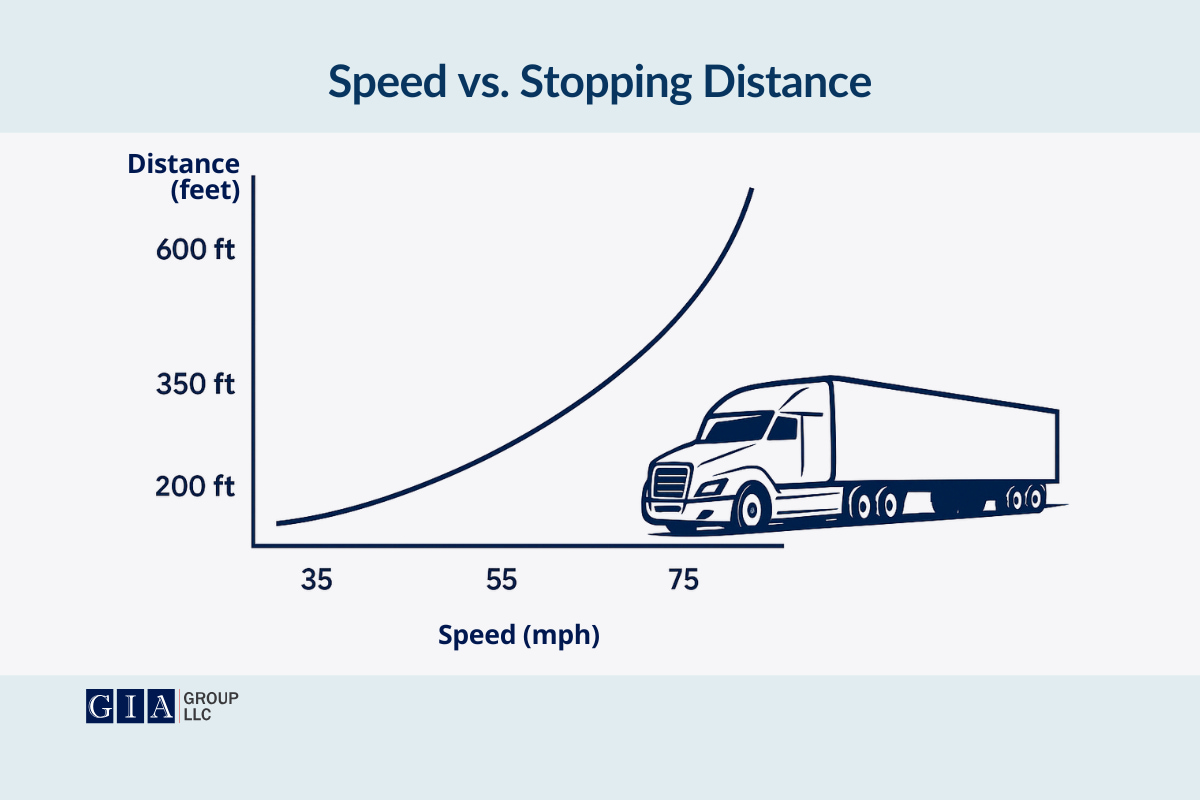Speeding remains one of the leading contributors to severe and fatal crashes on U.S. roads. The consequences of excessive speed are especially serious for commercial trucks, which can weigh up to 80,000 pounds when fully loaded. Besides the additional costs for violations, speeding increases the risk of accidents, magnifies the impact force, and reduces a driver’s ability to react in time to avoid hazards. It’s not just a matter of compliance—it’s a matter of safety and responsibility.
Whether you’re a fleet operator, an owner-operator, or part of a logistics team, understanding the risks of speeding is critical for safety, liability management, and long-term operational success.
Why Speeding Makes Truck Crashes More Dangerous
Large trucks take longer to stop than other types of vehicles. This is due to their size, weight, and braking system design. When speed increases, so does the stopping distance—and the margin for error shrinks.
According to the Insurance Institute for Highway Safety (IIHS), the risk of a fatal crash doubles with every 10 mph increase over 50 mph. That means a truck traveling at 70 mph is four times more likely to be involved in a fatal crash than one traveling at 50 mph.

In addition, faster speeds reduce the amount of time a driver has to recognize and react to road hazards. At 55 mph, a truck driver has about 4 seconds to respond to an obstacle ahead. At 70 mph, that reaction window drops to around 2.5 seconds—barely enough time to hit the brakes.
The Real-World Impact: By the Numbers
- In 2019, more than 5,000 people died in crashes involving large trucks in the U.S., according to the National Highway Traffic Safety Administration (NHTSA).
- Approximately 17% of those fatalities were truck occupants. The rest were occupants of other vehicles, motorcyclists, cyclists, or pedestrians.
- Speeding-related truck crashes often lead to serious injuries, including traumatic brain injuries, spinal injuries, and long-term disability.
Beyond Safety: The Hidden Costs of Speeding
Increased Financial Risk
A speeding-related crash can result in significant legal and financial consequences. Settlements, legal fees, insurance premium hikes, and potential regulatory penalties can cost trucking companies millions of dollars. Even a single incident can have a long-term financial impact.
Lower Fuel Efficiency
Driving at 75 mph instead of 65 mph can reduce a truck’s fuel efficiency by up to 27%. For a mid-size fleet, that could mean hundreds of thousands of dollars in wasted fuel annually.
Accelerated Wear and Tear
High speeds increase stress on tires, brakes, suspension, and other mechanical components. This leads to more frequent repairs, higher maintenance costs, and increased downtime.
Infrastructure Damage
When heavy trucks travel at high speeds, they contribute more to road surface deterioration. Faster-moving trucks put greater pressure on pavement, which can lead to premature wear and costly public infrastructure repairs.
Are There Solutions? Yes
Speed Limiters
Some fleets in the U.S. voluntarily install speed limiters—devices that cap a vehicle’s maximum speed. In places like Ontario, where speed limiters became mandatory for trucks in 2009, truck-related fatalities dropped by 24% over five years.
Technology Integration
Advanced driver-assistance systems (ADAS) can now detect unsafe speeds, alert drivers, and even engage braking systems automatically. These tools are gaining traction and could be a game changer for long-haul safety.
Training and Safety Incentives
Ongoing driver training programs that focus on defensive driving, emergency maneuvers, and load awareness have been shown to reduce crash risk. Some companies even tie safety bonuses to clean driving records and reduced violations.
Stronger Enforcement
States with stricter penalties for speeding—such as higher fines and increased enforcement—have reported measurable reductions in violations among commercial drivers.
More Speed Safety Tips
| Action | Result |
|---|---|
| Plan routes with realistic timelines to avoid rushing. | Reduces pressure to speed to meet delivery deadlines. |
| Maintain a safe following distance, especially at higher speeds. | Gives more reaction time and reduces collision risk. |
| Use cruise control wisely to help manage consistent speeds. | Helps maintain safe speeds, especially on long hauls. |
| Regularly inspect brakes and tires for optimal stopping power. | Ensures the vehicle can respond effectively when braking is needed. |
| Stay updated on local and state speed regulations for trucks. | Avoids costly violations and supports legal compliance. |
| Avoid aggressive driving behaviors like tailgating or rapid lane changes. | Minimizes crash risk and improves safety for all road users. |
| Use telematics or in-cab alerts to monitor and correct speeding habits. | Provides real-time data for safety improvements and coaching. |
| Prioritize driver training focused on speed management and hazard recognition. | Builds muscle memory and awareness in high-risk scenarios. |
The Bottom Line: Speed Responsibly
Speed might save a few minutes, but it can cost lives, livelihoods, and long-term stability. For truck drivers, speed management is more than a matter of personal safety—it’s a professional responsibility and a commitment to everyone sharing the road.
Every mile driven at a safe speed helps prevent tragedy, lowers operational costs, and strengthens your reputation as a safe, reliable carrier.
